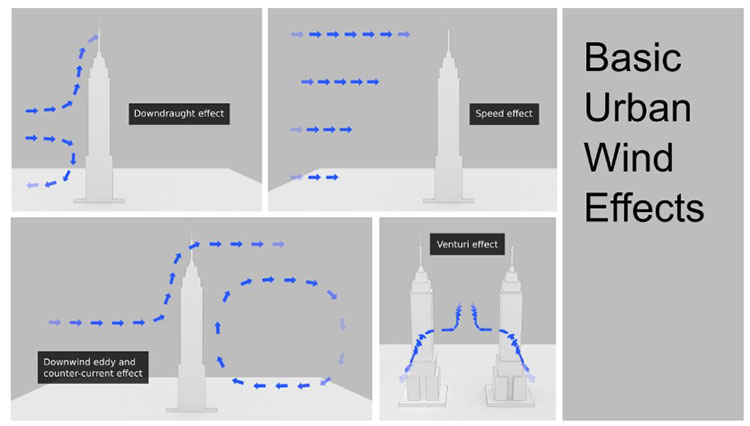Why does the wind look stronger than usual when standing near tall buildings?
We know that wind is the movement of air flow, formed by the change of atmospheric pressure, often going from a place of high pressure to low pressure.
Building an upstream structure means blocking the normal flow of wind and often causes the following two common phenomena:
- Downdraught effect , meaning that when the wind hits a building, is blocked, there is no other place to go, they will be pushed down, pushed up or into the sides of the building. Downward air pressure increases the wind speed in the area below the building
- Venturi effect - We imagine that when the water is upside down, because of the bottle neck, the water pressure is stronger than when we use a bottle with the same head and ass size

When the wind blows through the narrow range between buildings, the pressure will decrease and the wind speed increases.
In other words, when the liquid passes through the narrow position of the pipe, the initial pressure will decrease, but at the same time the velocity increases. And similarly to the wind, when the wind blows through the narrow range between buildings, the pressure will decrease and the wind speed increases.
Normally when building a building, in addition to many other calculations, one must simulate the wind model that affects the building in order to ensure the integrity and safety of the building, secondly to limit the occurrence of these phenomena.

Depending on the severity of the effects, the wind on the ground can be twice as strong as when it moves high up.
The effects mentioned above could be a threat to the safety of people living and working underneath the building. Depending on the severity of the effects, the wind on the ground can be twice as strong as when it moved at a height of several tens of meters above.
For example, a wind with a speed of about 40km / h can be amplified up to 55km / h below the building. And it is known that only one wind of 60km / h is enough to blow one person away.
- High-rise building
- Skyscrapers - unrealistic things are becoming reality!
- Wind energy is 100 times more than human needs
- In the future, modern buildings can save electricity thanks to ... pine cones
- Why did buildings collapse when the earthquake struck? The truth is more complicated than you think!
- Where can we build tall buildings?
- The stamina of humans before wind is stronger than 700km / h
- The world's first self-cooling building
- Robot cleaning glass of tall buildings
- Future environmentally friendly construction solutions
- Living on tall buildings will grow faster
- Russia built two strange buildings, all floors turned
 'Fine laughs' - Scary and painful torture in ancient times
'Fine laughs' - Scary and painful torture in ancient times The sequence of numbers 142857 of the Egyptian pyramids is known as the strangest number in the world - Why?
The sequence of numbers 142857 of the Egyptian pyramids is known as the strangest number in the world - Why? History of the iron
History of the iron What is alum?
What is alum?